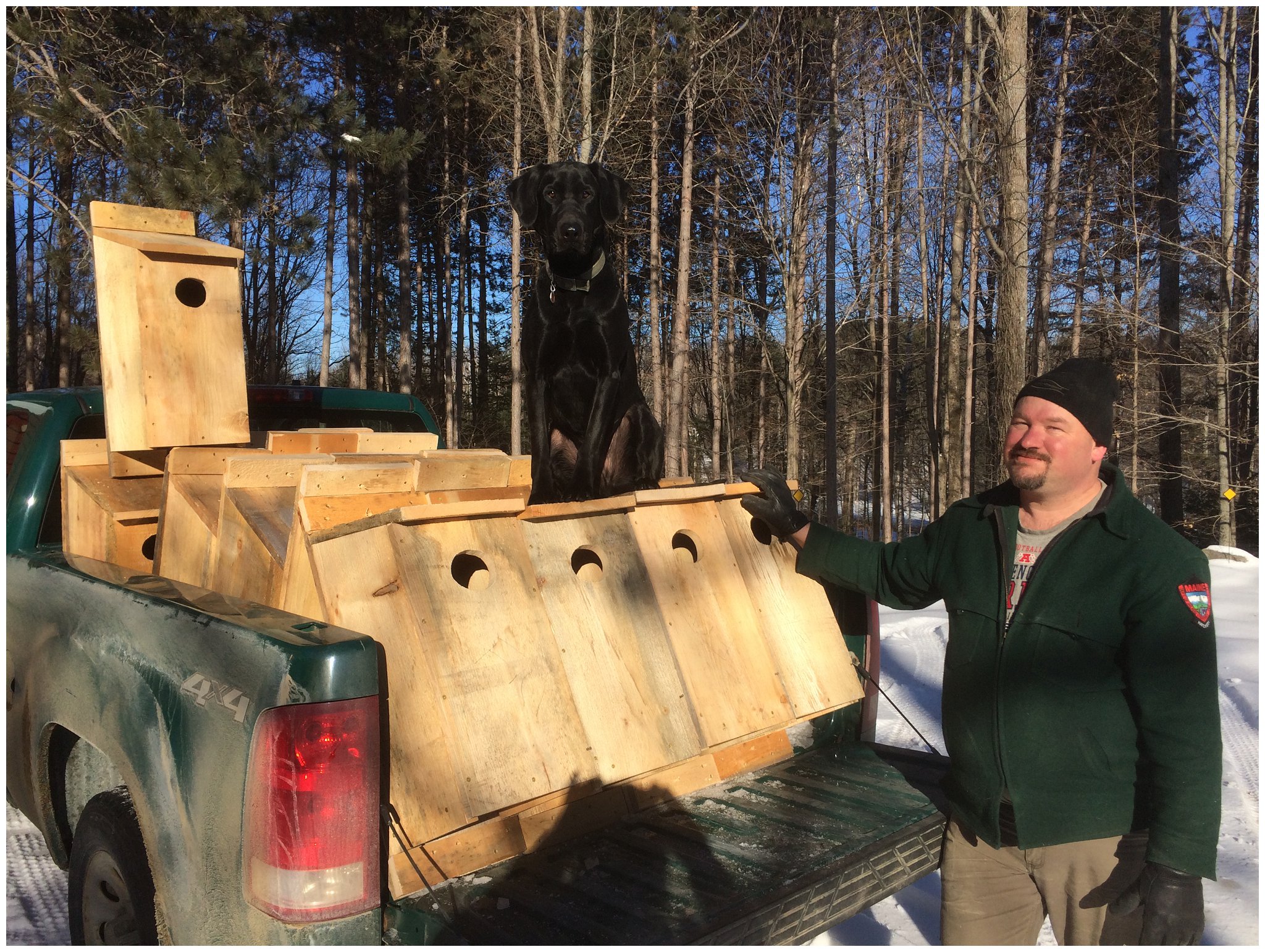ArrayMarch 10, 2016 at 1:43 pm
By Chuck Hulsey, Regional Wildlife Biologist
When you see a wooden box on a post over shallow water, with a hole in the front, you know that it is a nest box for wood ducks. Did you know Maine has other duck species which need tree cavities in order to nest and rear young? Though developed for wood ducks, they are commonly used by Hooded mergansers and American goldeneyes. “Wood duck boxes” may be the most recognizable wildlife management technique of all.
According to the Ducks Unlimited website: “In 1937, the U.S. Biological Survey (now the U.S. Fish & Wildlife Service) erected 486 bark-covered slab wooden boxes, which are thought to have been designed by biologists Gil Gigstead and Milford Smith at Chautauqua National Wildlife Refuge in central Illinois. This represented the first recorded use of artificial nesting structures for wood ducks. Over the next two years, Arthur Hawkins and renowned wood duck expert Frank Bellrose erected 700 rough-cut cypress board boxes throughout Illinois. More than half were used by "woodies," revealing the great management potential of the boxes. Since these pioneering efforts, thousands of wood duck boxes have been built and erected by a diversity of people and groups, from wildlife agencies to conservation-minded private citizens”.
Department regional wildlife biologists maintain almost 1000 waterfowl nest boxes on our wetland-based Wildlife Management Areas. Most are checked and maintained annually. This is done for basic maintenance, to refresh the shavings to reduce nest parasites, to increase use, and to monitor productivity. You can watch the short video below to see how we do this. Yes, it is a fun job.
[embed]https://youtu.be/d2fMhEa5Ogg[/embed]
A well-built waterfowl and maintained nest box will last 15-20 years. The story of how we get the materials is an interesting one. The basic math explains the annual need of about 40 new boxes. MDIFW has not had to buy a board for 27 years.
Around 1989 I approached the mill manager at LaValley Lumber in Sanford to request a donation of lumber to build 10 boxes. He said I could have rough-sawn green boards that broke (lengthwise), as they normally would be chipped and burned for fuel. These would be perfect. That relationship blossomed to the point where this mill donated all the rough lumber for the entire MDIFW’s nest box program for nearly two dozen years.
[caption id="attachment_1310" align="aligncenter" width="593"] Fish and Wildlife Technician Paul Campbell with a truck load of duck boxes that he built with lumber donated from Pleasant River Pine in Sanford.[/caption]
In recent years, that mill was purchased by Pleasant River Pine. The former mill manager eased the transition through the company change. Through their generosity, MDIFW still continues to receive donated lumber to supply all our needs. MDIFW Fish and Wildlife Technician Paul Campbell coordinates this effort with Pleasant River Pine's General Manager Jamie Fall. Many thanks for your generosity over so many years.
Fish and Wildlife Technician Paul Campbell with a truck load of duck boxes that he built with lumber donated from Pleasant River Pine in Sanford.[/caption]
In recent years, that mill was purchased by Pleasant River Pine. The former mill manager eased the transition through the company change. Through their generosity, MDIFW still continues to receive donated lumber to supply all our needs. MDIFW Fish and Wildlife Technician Paul Campbell coordinates this effort with Pleasant River Pine's General Manager Jamie Fall. Many thanks for your generosity over so many years.
 Fish and Wildlife Technician Paul Campbell with a truck load of duck boxes that he built with lumber donated from Pleasant River Pine in Sanford.[/caption]
In recent years, that mill was purchased by Pleasant River Pine. The former mill manager eased the transition through the company change. Through their generosity, MDIFW still continues to receive donated lumber to supply all our needs. MDIFW Fish and Wildlife Technician Paul Campbell coordinates this effort with Pleasant River Pine's General Manager Jamie Fall. Many thanks for your generosity over so many years.
Fish and Wildlife Technician Paul Campbell with a truck load of duck boxes that he built with lumber donated from Pleasant River Pine in Sanford.[/caption]
In recent years, that mill was purchased by Pleasant River Pine. The former mill manager eased the transition through the company change. Through their generosity, MDIFW still continues to receive donated lumber to supply all our needs. MDIFW Fish and Wildlife Technician Paul Campbell coordinates this effort with Pleasant River Pine's General Manager Jamie Fall. Many thanks for your generosity over so many years.
Categories